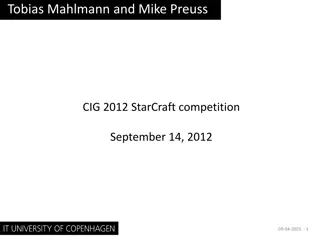
Growth and Development of Plant Cells: Understanding the Intricacies
Explore the fascinating world of cellular development in plants, diving into topics like cell walls, growth dynamics, and signal perception. Delve into the complexities of plant cell growth, from primary walls to cellulose microfibrils, unraveling the structural components that shape plant life.
Download Presentation

Please find below an Image/Link to download the presentation.
The content on the website is provided AS IS for your information and personal use only. It may not be sold, licensed, or shared on other websites without obtaining consent from the author. If you encounter any issues during the download, it is possible that the publisher has removed the file from their server.
You are allowed to download the files provided on this website for personal or commercial use, subject to the condition that they are used lawfully. All files are the property of their respective owners.
The content on the website is provided AS IS for your information and personal use only. It may not be sold, licensed, or shared on other websites without obtaining consent from the author.
E N D
Presentation Transcript
KINGDOOM OF SAUDI ARABIA King Saud University College of Sciences - Department Botany & Microbiology Morphogenesis BIO 312 Dr. Abdulrahman AL-hashimi
Lecture 3 Growth and Development of Cells
Growth and Development of Cells The development of a whole plant, as intricate as it may seem, ultimately depends on: The growth and coordinated development of individual cells and groups of cells This chapter provides a general introduction to selected aspects of cellular development, including 1. The structure of plant cell walls, 2. The dynamics of cell division and cell growth, and 3. an overview of signal perception and the signal chains that enable cells to respond to those signal.
GROWTH OF PLANT CELLS IS COMPLICATED BY THE PRESENCE OF A CELL WALL Plant cells are characterized by a complex mixture of materials, called the extracellular matrix (ECM) That lie outside the plasma membrane. The ECM is dominated by the cell wall, which provides protection for the underlying protoplast and is ultimately responsible for maintaining cell shape and the structural integrity of the plant. Two types of cell walls are recognized: primary walls, which surround young, actively growing cells, and secondary walls that are laid down as the cells mature and are no longer growing.
THE PRIMARY CELL WALL IS A NETWORK OF CELLULOSE MICROFIBRILS AND CROSS-LINKING GLYCANS The primary wall is very thin, measuring only a few micrometers in thickness. Its principal constituent is long, threadlike chains of 1 4 linked glucose units, called cellulose. The individual cellulose molecules are bundled in long, parallel arrays called microfibrils. Each microfibril is approximately 5 to 12 nm in diameter and contains, in higher plants, approximately 36 individual cellulose chains in cross-section.
A single cellulose chain may contain as many as 3,000 or more glucose units but, because the chains begin and end at different places within the microfibril, an individual microfibril may contain several thousand cellulose chains and reach lengths of several hundred micrometers. Adjacent cellulose chains within a microfibril are held together by hydrogen bonds between hydroxyl ( OH) groups on adjacent glucose units. This bonding arrangement makes a microfibril very strong.
The cellulose microfibrils within the primary wall are held in position by cross-linking glycans. Cross-linking glycans are noncellulosic polysaccharides that bind to the cellulose microfibrils, but are also long enough to bridge the distance between neighboring microfibrils and link them into a semi-rigid network. In the primary cell wall of all dicotyledonous (dicot) species and about one-half of the monocotyledons (monocot) species, the principal cross-linking glycans are xyloglycans (XyGs).
THE CELLULOSEGLYCAN LATTICE IS EMBEDDED IN A MATRIX OF PECTIN AND PROTEIN About 35 percent of the primary wall consists of pectins, or pectic substances. Pectin is a complex, heterogeneous mixture of noncellulosic polysaccharides especially rich in galacturonic acid the acid form of the sugar galactose. When the pectin chain is secreted into the wall space, most of the free carboxylic acid groups are esterified with methyl groups Once in the wall, however, the enzyme pectin methylesterase cleaves some of the methyl groups, leaving the acid groups free to bind with calcium.
The divalent calcium ions form cross-links between pectin chains and contribute to the stability of the cell wall. It is significant that calcium concentrations (and, consequently, calcium bridging) are kept low in the walls of actively growing cells. Pectins are also the principal constituent of the middle lamella. The middle lamella lies between the primary walls of adjacent cells.
The softening of fruit as it ripens, for example, is due in part to the action of the enzyme polygalacturonase, which degrades the pectic substances in the middle lamella and loosens of the bonds between the cells.
CELLULOSE MICROFIBRILS ARE ASSEMBLED AT THE PLASMA MEMBRANE AS THEY ARE EXTRUDED INTO THE CELL WALL
Cellulose synthesis is catalyzed by cellulose synthase, a multimeric enzyme that is localized in the plasma membrane The immediate precursor for cellulose synthesis is uridine diphosphoglucose (UDP-Glu). UDP-Glu can be formed directly from sucrose by certain forms of the enzyme sucrose synthase, and also appears to be associated with the plasma membrane.
Cellulose synthesis is catalyzed by cellulose synthase, a multimeric enzyme that is localized in the plasma membrane. Although active cellulose synthase has proven difficult to isolate. the enzyme complex can be visualized in electron micrographs of membranes prepared by a technique known as freeze-fracturing. At least in angiosperms, the enzyme appears to be organized in the form of a rosette composed of six subunits.
The rosette not only synthesizes the cellulose chain, but assembles the chains into microfibrils and extrudes the microfibrils into the cell wall. CELL DIVISION: The division of plant cells, like any eukaryotic cell, occurs in two steps: mitosis or karyokinesis. The results in the creation of two new nuclei, and cytokinesis, the subsequent division of the cytoplasm to create two separate daughter cells. however, each of the daughter cells must increase the amount of cytoplasm as it enlarges, replicate its DNA, and prepare for the next division. This sequence of events is known as the cell cycle
THE CELL CYCLE The cell cycle can be described as four distinct phases: the mitotic phase (M), the DNA synthesis phase (S), two intervening phases or gaps (G1 and G2) The M phase is the division phase in which chromosomes are condensed and their distinctive morphology becomes visible with a light microscope. Throughout the other three phases, collectively referred to as interphase
During S phase, DNA replication leads to the formation of two identical copies of the chromosomes. In the G2 phase, the chromosomes begin to condense and the cell assembles the rest of the machinery necessary to move the chromosomes apart during mitosis.
The required control is achieved through a complex interplay of various kinases, phosphatases, and proteases that respond to both intrinsic and external signals. Central to cell cycle control are the activities of cyclin- dependent kinases (CDKs). CDKs are composed of two subunits one subunit functions as a catalyst and the other serves to activate the complex. The activating subunit is a small, unstable protein called cyclin, In plants, there are at least four classes of cyclins (A, B, D, and H) and the association of CDKs with specific cyclins is a key regulatory factor.
CYTOKINESIS Cytokinesis in animal cells is relatively simple, involving a constriction of the cell membrane which advances toward the center until the one cell becomes two cells. The existence of the cell wall prevents a similar pattern of cell division in plant cells. The existence of the cell wall prevents a similar pattern of cell division in plant cells. Plant cells must instead construct new membranes and a new extracellular matrix, including a middle lamella and two new primary walls, inside a living cell.
The formation of the new walls begins in the late mitotic or M phase of the cell cycle, after the two sets of chromosomes have separated and moved toward opposite poles in the cell and the new nuclear membranes have begun to form. At this point, the mitotic spindle disappears and the microtubules that had made up the spindle disassemble and then reassemble to form a cluster of interdigitating microtubules oriented perpendicular to the plane of the new crosswall
CELL WALLS AND CELL GROWTH Although the primary wall is not very thick, its interlocking network of cellulose microfibrils, cross-linking xyloglycans, and structural proteins confers remarkable strength and rigidity to the wall. This strength and rigidity maintains the shape of the cell and its structural relationship with neighboring cells and, ultimately, the support of the entire plant. Thus a growing cell faces a delicate balancing act.
CELL GROWTH IS DRIVEN BY WATER UPTAKE AND LIMITED BY THE STRENGTH AND RIGIDITY OF THE CELL WALL
The cell will also not take up water and it will not grow. The driving force for cell enlargement is the uptake of water. Recall that cells take up water by the process of osmosis. The high solute concentration of the protoplasm and vacuolar sap decreases the water potential of the cell to the point where water diffuses into the cell
Turgor pressure (a positive pressure) developed as the expanding protoplast pushes against the wall rises until it balances the negative osmotic pressure of the protoplast. At that point the water potential of the cell approaches zero and no further net water uptake or cell growth will occur.
Any QUESTIONS ?











